Appendix A Throwers’ Ten Exercise Program
The Throwers’ Ten Exercise Program* is designed to exercise the major muscles necessary for throwing. The goal of the program is to be an organized and concise exercise program. In addition, all exercises included are specific to the thrower and are designed to improve strength, power, and endurance of the musculature of the shoulder complex.
Diagonal Pattern (D2) Extension. The athlete grips the tubing handle overhead and out to the side with the involved hand. The athlete pulls the tubing down and across the body to the opposite side of the leg (Fig. A-1, A). During the motion, the athlete leads with the thumb.
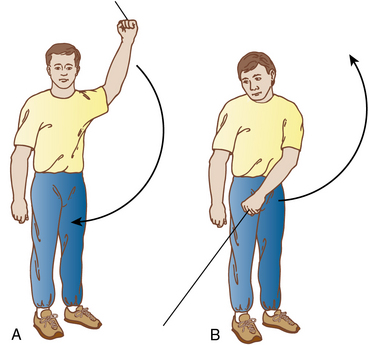
Figure A-1 Diagonal patterns. A, Extension. B, Flexion.
(Redrawn from Wilk, K.E., Andrews, J.R., Arrigo, C.A., et al. [2001]: Preventive and Rehabilitative Exercises for the Shoulder and Elbow, 5th ed. Birmingham, AL, American Sports Medicine Institute.)
Diagonal Pattern (D2) Flexion. The athlete grips the tubing handle in the hand of the involved arm and brings the arm out 45° from the side, palm facing backward. After turning the palm forward, the athlete proceeds to flex the elbow and bring the arm up and over the uninvolved shoulder (Fig. A-1, B). The palm is turned down and reversed to take the arm to the starting position. The exercise should be performed in a controlled manner.
External Rotation at 0° Abduction. The athlete stands with the involved elbow fixed at the side, elbow at 90°, and the involved arm across the front of the body. The athlete grips the tubing handle (the other end of the tubing is fixed), pulls out with the arm while keeping the elbow at the side (Fig. A-2, A), and returns the tubing slowly and in a controlled manner.


Figure A-2 A, External rotation at 0° abduction. B, Internal rotation at 0° abduction. C, External rotation at 90° abduction. D, Internal rotation at 90° abduction.
(Redrawn from Wilk, K.E., Andrews, J.R., Arrigo, C.A., et al. [2001]: Preventive and Rehabilitative Exercises for the Shoulder and Elbow, 5th ed. Birmingham, AL, American Sports Medicine Institute.)
Internal Rotation at 0° Abduction. The athlete stands with the elbow at the side, fixed at 90°, with the shoulder rotated out. The athlete grips the tubing handle (the other end of the tubing is fixed), pulls the arm across the body while keeping the elbow at the side (Fig. A-2, B), and returns the tubing slowly and in a controlled manner.
External Rotation at 90° Abduction. The athlete stands with the shoulder abducted to 90° and the elbow flexed to 90°. The athlete grips the tubing handle (the other end is fixed straight ahead, slightly lower than the shoulder). Keeping the shoulder abducted, the athlete rotates the shoulder back while keeping the elbow at 90° (Fig. A-2, C). Slow- and fast-speed sets should be performed with the tubing. The clinician will need to change the tubing resistance as appropriate.
Internal Rotation at 90° Abduction. The athlete stands with the shoulder abducted to 90° and externally rotated to 90° and the elbow bent to 90°. Keeping the shoulder abducted, the athlete rotates the shoulder forward while keeping the elbow bent at 90° (Fig. A-2, D) and then returns the tubing and hand to the starting position. Slow- and fast-speed sets should be performed with the tubing. The clinician will need to change the tubing resistance as appropriate.
Shoulder Abduction to 90°. The athlete stands with the arm at the side, the elbow straight, and the palm against the side and raises the arm to the side, palm down, until the arm reaches 90° (shoulder level) (Fig. A-3). The athlete holds the position for 2 seconds and lowers the arm slowly.
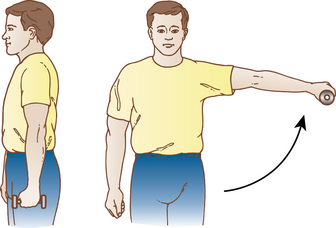
Figure A-3 Shoulder abduction to 90°.
(Redrawn from Wilk, K.E., Andrews, J.R., Arrigo, C.A., et al. [2001]: Preventive and Rehabilitative Exercises for the Shoulder and Elbow, 5th ed. Birmingham, AL, American Sports Medicine Institute.)
Scaption, External Rotation. The athlete stands with the elbow straight and thumb up and raises the arm to shoulder level at a 30° angle in front of the body (Fig. A-4) while not going above shoulder height. The athlete holds the position for 2 seconds and lowers the arm slowly.
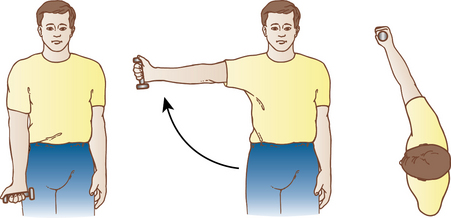
Figure A-4 Scaption external rotation.
(Redrawn from Wilk, K.E., Andrews, J.R., Arrigo, C.A., et al. [2001]: Preventive and Rehabilitative Exercises for the Shoulder and Elbow, 5th ed. Birmingham, AL, American Sports Medicine Institute.)
Side-Lying External Rotation. The athlete lies on uninvolved side with the involved arm at the side of the body and the elbow bent to 90°. While keeping the elbow of the involved arm fixed to the side, the athlete raises the arm.
Prone Horizontal Abduction (Neutral). The athlete lies on the table, face down, with the involved arm hanging straight to the floor and the palm facing down. The arm is raised out to the side, parallel to the floor (Fig. A-5, A). The athlete holds the position for 2 seconds and lowers the arm slowly.

Figure A-5 Prone horizontal abduction. A, Neutral. B, Full external rotation, 100° abduction.
(Redrawn from Wilk, K.E., Andrews, J.R., Arrigo, C.A., et al. [2001]: Preventive and Rehabilitative Exercises for the Shoulder and Elbow, 5th ed. Birmingham, AL, American Sports Medicine Institute.)
Prone Horizontal Abduction (Full External Rotation, 100° Abduction). The athlete lies on the table, face down, with the involved arm hanging straight to the floor and the thumb rotated up (hitchhiker position). The arm is raised out to the side with the arm slightly in front of the shoulder, parallel to the floor (Fig. A-5, B). The athlete holds the position for 2 seconds and lowers the arm slowly.
Press-Ups. The athlete, seated on a chair or on a table, places both hands firmly on the sides of the chair or table, palms down and fingers pointed outward. The hands should be on a straight line with the shoulders. The athlete slowly pushes downward through the hands to elevate the body (Fig. A-6). The athlete holds the elevated position for 2 seconds and lowers the body.
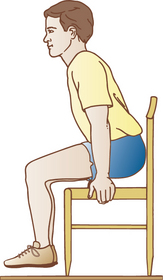
(Redrawn from Wilk, K.E., Andrews, J.R., Arrigo, C.A., et al. [2001]: Preventive and Rehabilitative Exercises for the Shoulder and Elbow, 5th ed. Birmingham, AL, American Sports Medicine Institute.)
Prone Rowing. The athlete lies on the stomach with the involved arm hanging over the side of the table, a dumbbell in the hand, and the elbow straight. The athlete slowly raises the arm, bends the elbow, and lifts the dumbbell as high as possible (Fig. A-7). The athlete holds the position for 2 seconds and lowers the arm slowly.
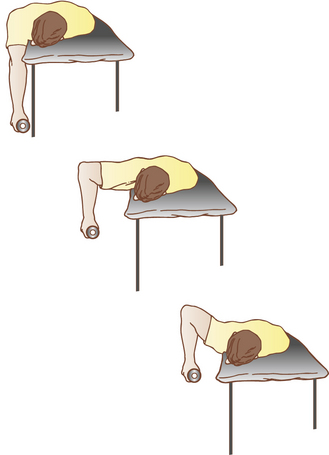
(Redrawn from Wilk, K.E., Andrews, J.R., Arrigo, C.A., et al. [2001]: Preventive and Rehabilitative Exercises for the Shoulder and Elbow, 5th ed. Birmingham, AL, American Sports Medicine Institute.)
Prone Rowing Into External Rotation. The athlete lies on the stomach with the involved arm hanging over the side of the table, a dumbbell in the hand, and the elbow straight. The athlete slowly raises the arm and bends the elbow up to the level of the table. After a pause of 1 second, the athlete rotates the shoulder upward until the dumbbell is even with the table while keeping the elbow at 90°. The athlete holds the position for 2 seconds and then slowly lowers the arm.
Push-Ups. The athlete starts in the down position with the arms in a comfortable position. The hands should be placed no more than shoulder width apart. The athlete pushes up as high as possible by rolling the shoulders forward after the elbows are straight (Fig. A-8). The athlete can start with a push-up into the wall and gradually progress to a table and eventually to the floor, as tolerated.
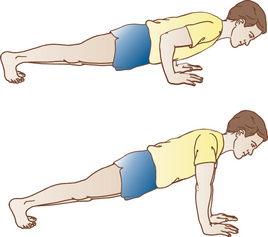
(Redrawn from Wilk, K.E., Andrews, J.R., Arrigo, C.A., et al. [2001]: Preventive and Rehabilitative Exercises for the Shoulder and Elbow, 5th ed. Birmingham, AL, American Sports Medicine Institute.)
Elbow Flexion. With the arm against the side and the palm facing inward, the athlete bends the elbow upward while turning the palm up as the movement progresses (Fig. A-9, A). The athlete holds the position for 2 seconds and lowers the elbow slowly.
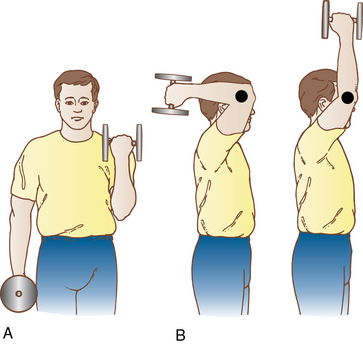
Figure A-9 A, Elbow flexion. B, Elbow extension.
(Redrawn from Wilk, K.E., Andrews, J.R., Arrigo, C.A., et al. [2001]: Preventive and Rehabilitative Exercises for the Shoulder and Elbow, 5th ed. Birmingham, AL, American Sports Medicine Institute.)
Elbow Extension. The athlete raises the involved arm overhead, with the uninvolved hand providing support at the elbow. The arm is straightened overhead (Fig. A-9, B). The athlete holds the position for 2 seconds and lowers the arm slowly.
Wrist Extension. Supporting the forearm and with the palm facing downward, the athlete raises a weight in the hand as far as possible (Fig. A-10, A). The athlete holds the position for 2 seconds and lowers the arm slowly.
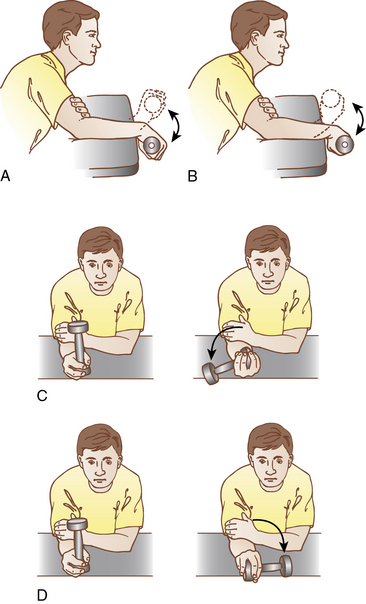
Figure A-10 A, Wrist extension. B, Wrist flexion. C, Wrist supination. D, Wrist pronation.
(Redrawn from Wilk, K.E., Andrews, J.R., Arrigo, C.A., et al. [2001]: Preventive and Rehabilitative Exercises for the Shoulder and Elbow, 5th ed. Birmingham, AL, American Sports Medicine Institute.)
Wrist Flexion. Supporting the forearm and with the palm facing upward, the athlete lowers a weight in the hand as far as possible and then curls it up as high as possible (Fig. A-10, B). The athlete holds the position for 2 seconds and lowers the arm slowly.
Wrist Supination. The athlete supports the forearm on a table with the wrist in a neutral position. Using a weight or a hammer, the athlete rolls the wrist, taking the palm up (Fig. A-10, C). The athlete holds the position for 2 seconds, and the arm is returned to the starting position.
Wrist Pronation. The athlete supports the forearm on a table with the wrist in a neutral position. Using a weight or hammer, the athlete rolls the wrist, taking the palm down (Fig. A-10, D). The athlete holds the position for 2 seconds, and the arm is returned to the starting position.